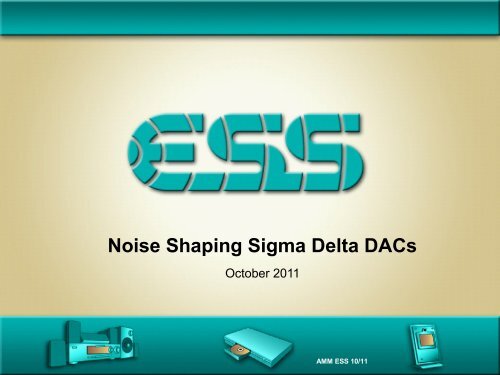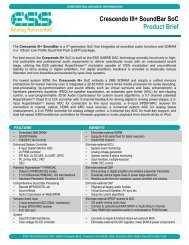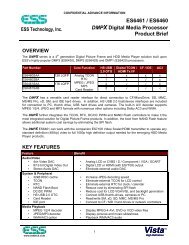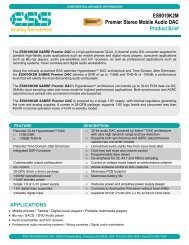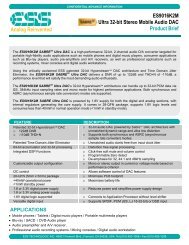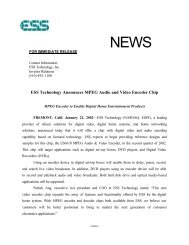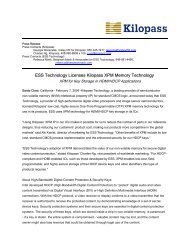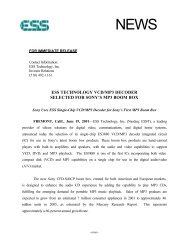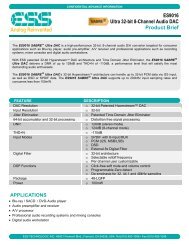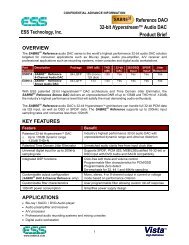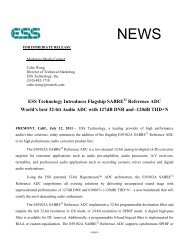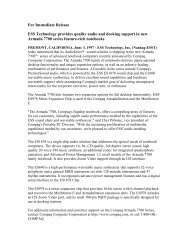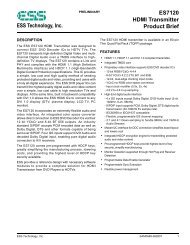Noise Shaping Sigma Delta DACs - ESS Technology, Inc.
Noise Shaping Sigma Delta DACs - ESS Technology, Inc.
Noise Shaping Sigma Delta DACs - ESS Technology, Inc.
Create successful ePaper yourself
Turn your PDF publications into a flip-book with our unique Google optimized e-Paper software.
<strong>Noise</strong> <strong>Shaping</strong> <strong>Sigma</strong> <strong>Delta</strong> <strong>DACs</strong><br />
October 2011<br />
AMM <strong>ESS</strong> 10/11
Overview of this Presentation<br />
• About <strong>ESS</strong> <strong>Technology</strong><br />
• Simple <strong>Noise</strong> <strong>Shaping</strong><br />
• The “magic” step...<br />
• ΣΔ Modulators<br />
• Beyond the ΣΔ modulator<br />
– ΣΔ artifacts and understanding what<br />
Audiophiles are hearing<br />
– What the <strong>ESS</strong> HyperStream does differently<br />
ΣΔ/HyperStream 2 of 44
Corporate Overview<br />
• <strong>ESS</strong> was founded in 1984<br />
– Fabless semiconductor supplier<br />
– Market is consumer digital entertainment<br />
– Headquartered in Silicon Valley with worldwide branches<br />
• <strong>ESS</strong> has a long history of being the market leader<br />
– 1989 #1 supplier: Sound chips for toy industry<br />
– 1995-1999 #1 supplier: PC Audio chips<br />
– 1998-2005 #1 supplier: Digital video chips<br />
– 2008 Sabre DAC: Highest Performance Audio DAC<br />
– 2011 Sabre ADC: Highest Performance Audio ADC<br />
ΣΔ/HyperStream 3 of 44
What we make at <strong>ESS</strong><br />
• Sound-bar Chips<br />
– You may already have a HyperStream modulator in your home:<br />
We make the chips used in many Sound-bars today.<br />
• Home Theater Chips<br />
– If you purchased a Home Theater (or DVD player) you probably have a<br />
HyperStream modulator in your home.<br />
<strong>ESS</strong> chips were in about 30% of all DVD players, and in many Home<br />
Theater systems today.<br />
• High Performance DAC<br />
– The Sabre product line of highest performance <strong>DACs</strong> (and lately ADCs)<br />
are in many high-end systems.<br />
ΣΔ/HyperStream 4 of 44
<strong>ESS</strong> Locations<br />
ΣΔ/HyperStream 5 of 44
Overview of this Presentation<br />
• About <strong>ESS</strong> <strong>Technology</strong><br />
• Simple <strong>Noise</strong> <strong>Shaping</strong><br />
• The “magic” step...<br />
• ΣΔ Modulators<br />
• Beyond the ΣΔ modulator<br />
– ΣΔ artifacts and understanding what<br />
Audiophiles are hearing<br />
– What the <strong>ESS</strong> HyperStream does differently<br />
ΣΔ/HyperStream 6 of 44
What is the price of Gas? (1)<br />
• Apparently, it is<br />
121.9 cents<br />
Before you start<br />
crossing the border<br />
to Canada to buy<br />
gas, this is per litre<br />
not per gallon!<br />
ΣΔ/HyperStream 7 of 44
What is the price of Gas? (2)<br />
1 Mon $1.22<br />
2 Tue $1.22<br />
3 Wed $1.22<br />
4 Thu $1.22<br />
5 Fri $1.22<br />
6 Sat $1.22<br />
7 Sun $1.22<br />
8 Mon $1.22<br />
9 Tue $1.22<br />
10 Wed $1.22<br />
11 Thu $1.22<br />
12 Fri $1.22<br />
13 Sat $1.22<br />
14 Sun $1.22<br />
15 Mon $1.22<br />
16 Tue $1.22<br />
17 Wed $1.22<br />
18 Thu $1.22<br />
19 Fri $1.22<br />
20 Sat $1.22<br />
• Buy one litre per day for a few<br />
days. What do you have to pay?<br />
• Because that 0.9 is less than one<br />
cent, the cashier must charge<br />
you the nearest possible price:<br />
$1.22<br />
• Had you not seen the sign, you<br />
would conclude that the price,<br />
based on buying gas 20 times,<br />
was $1.22<br />
ΣΔ/HyperStream 8 of 44
What is the price of Gas? (3)<br />
1 Mon $1.22<br />
2 Tue $1.22<br />
3 Wed $1.22<br />
4 Thu $1.22<br />
5 Fri $1.22<br />
6 Sat $1.22<br />
7 Sun $1.22<br />
8 Mon $1.22<br />
9 Tue $1.22<br />
10 Wed $1.21<br />
11 Thu $1.22<br />
12 Fri $1.22<br />
13 Sat $1.22<br />
14 Sun $1.22<br />
15 Mon $1.22<br />
16 Tue $1.22<br />
17 Wed $1.22<br />
18 Thu $1.22<br />
19 Fri $1.22<br />
20 Sat $1.21<br />
• What's happening here?<br />
You are not getting the same<br />
price each day, something is<br />
wrong – why does the price differ<br />
on day 10 and day 20?<br />
• Interestingly, you would now<br />
conclude that the price is 121.9<br />
based on your 20 samples.<br />
Which is actually correct..<br />
The cashier is keeping track<br />
of the accumulating error in<br />
the price you are paying<br />
ΣΔ/HyperStream 9 of 44
The Trick is “<strong>Noise</strong> <strong>Shaping</strong>”<br />
• This method of making the error average out to zero is<br />
called “<strong>Noise</strong> <strong>Shaping</strong>”<br />
– It is so called because it does not just ignore the quantization<br />
noise: it keeps track of it, and reduces the average to zero<br />
• In the “Gas Price” example, the cashier adds up the error<br />
and gives you back a penny every now and again to stop<br />
the error accumulating<br />
ΣΔ/HyperStream 10 of<br />
44
Does <strong>Noise</strong> <strong>Shaping</strong> help Audio?<br />
• This is a conventional 16bit DAC<br />
It is very good indeed, even before<br />
we try this noise shaping trick...<br />
Zoom in: Ideal DAC<br />
• We have to look at a tiny signal to<br />
see where it differs from the<br />
mathematical ideal<br />
ΣΔ/HyperStream 11 of<br />
44
Does <strong>Noise</strong> <strong>Shaping</strong> help Audio? (2)<br />
• Zoom in even more – we can now<br />
see the quatization steps clearly.<br />
• Now we allow the DAC to shape<br />
Ideal DAC <strong>Noise</strong>-Shaped<br />
the noise: we allow it to give us not<br />
just one number, but two, such that<br />
the average number is closer to<br />
the ideal<br />
This is still a NOS* DAC: it has not generated<br />
another sample, it is simply not making a<br />
constant value from that sample.<br />
This is still a 16 bit DAC: it has not created<br />
any more output levels, it is simply using the<br />
levels it already has.<br />
*NOS DAC: Non-Oversampling Digital to Analog Convertor<br />
ΣΔ/HyperStream 12 of<br />
44
How do we know which is best?<br />
These marvellous<br />
Victorian machines<br />
will help us: these<br />
are Fourier<br />
Analysis machines<br />
and were designed<br />
to predict the tides<br />
William Thomson (later Lord Kelvin) tells us:<br />
“The mechanical method which I have utilised in this machine is<br />
primarily due to the Rev. F. Bashforth ... 1845, ... 'A Description of a<br />
Machine for finding the Numerical Roots of Equations and tracing a<br />
Variety of Useful Curves,' ...”<br />
ΣΔ/HyperStream 13 of<br />
44
Victorian Analysis machines<br />
The graph above is the height of the<br />
tides at a certain Indian port in the<br />
British Empire in 1900<br />
Kelvin's (Thomson's) machine<br />
breaks the signal down into<br />
components: mostly just under two<br />
cycles per day as we see<br />
This is “Fourier Analysis”<br />
ΣΔ/HyperStream 14 of<br />
44
We look in the Frequency Domain<br />
<strong>Noise</strong><br />
Shaped<br />
DAC<br />
Ideal<br />
To find which is best, we need to look in the frequency<br />
domain. Here are those results from the noise shaped DAC<br />
slide after transformation into the frequency domain.<br />
Look how effective those little<br />
“dithers” are on the otherwise fixed<br />
levels: the region of 1kHz has<br />
improved by about 20dB (factor of 10)<br />
ΣΔ/HyperStream 15 of<br />
44
It's the “Gas Price” trick in Audio<br />
• So far nothing too<br />
surprising: the “Gas<br />
Price” trick is just a<br />
means to stop the error<br />
from growing by<br />
keeping track of it, so<br />
that “on average” it is<br />
correct.<br />
• We understand it as<br />
being mostly a DAC,<br />
with a little noiseshaping<br />
trick.<br />
ΣΔ/HyperStream 16 of<br />
44
Overview of this Presentation<br />
• About <strong>ESS</strong> <strong>Technology</strong><br />
• Simple <strong>Noise</strong> <strong>Shaping</strong><br />
• The “magic” step...<br />
• ΣΔ Modulators<br />
• Beyond the ΣΔ modulator<br />
– ΣΔ artifacts and understanding what<br />
Audiophiles are hearing<br />
– What the <strong>ESS</strong> HyperStream does differently<br />
ΣΔ/HyperStream 17 of<br />
44
Very interesting FFT Plot...<br />
• If you accept the red and green plots,<br />
what do you think of the blue one?<br />
It appears to have much, much lower noise in the Audio band...<br />
ΣΔ/HyperStream 18 of<br />
44
This is a valuable technology....<br />
The really<br />
low noise<br />
graph has<br />
only two<br />
levels!<br />
It's all noise<br />
shaping and<br />
no DAC<br />
We don't<br />
need the<br />
expense of<br />
making a<br />
DAC<br />
ΣΔ/HyperStream 19 of<br />
44
Beginnings of a ΣΔ modulator<br />
• Clearly, there is something much more than the “Gas<br />
Price” trick going on here.<br />
– The “magic” is to do with how you give that penny back: you can<br />
do it such that the error is very small indeed<br />
• The name “ΣΔ modulator” has come to generically<br />
describe these advanced forms of noise shaping loops.<br />
– Being Audiophiles, you can probably accept the<br />
simple noise shaping on the 16bit DAC levels, it's still<br />
a DAC after all.<br />
– But, what are we to make of a “DAC” that has only<br />
two levels? It's all noise-shaping and no DAC!<br />
ΣΔ/HyperStream 20 of<br />
44
Overview of this Presentation<br />
• About <strong>ESS</strong> <strong>Technology</strong><br />
• Simple <strong>Noise</strong> <strong>Shaping</strong><br />
• The “magic” step...<br />
• ΣΔ Modulators<br />
• Beyond the ΣΔ modulator<br />
– ΣΔ artifacts and understanding what<br />
Audiophiles are hearing<br />
– What the <strong>ESS</strong> HyperStream does differently<br />
ΣΔ/HyperStream 21 of<br />
44
<strong>Delta</strong> Modulator in the 11 th Century<br />
• In about 1079 Omar Khayyam (an Islamic<br />
astronomer) in Iran, instituted a scheme of leap<br />
years that was actually a first order ΣΔ modulator!<br />
– His procedure was accurate, and did not accumulate<br />
errors, unlike the one proposed 500 years later...<br />
ΣΔ/HyperStream 22 of<br />
44
Modulators<br />
Omar Khayyam uses error<br />
minimizing algorithm in the<br />
Iranian Calendar: a 1 st order ΣΔ<br />
The Gregorian<br />
Calendar uses the<br />
SN7497 algorithm<br />
for leap years 1953<br />
c.1950<br />
c. 1975<br />
1972 1980's 2005+<br />
1079<br />
1582<br />
France: video encoder<br />
Bendix Digital Differential Analyzer<br />
TI Sync. Binary Rate Multiplier SN7497<br />
UK Post Office/Ferranti PCM1/PCM2<br />
and the Consumer Micro-Circuits FX209<br />
Crystal Semiconductor ΣΔ – many products<br />
Many other companies (ADI, TI, Wolfson etc.) start to make ΣΔ's<br />
<strong>ESS</strong> <strong>Technology</strong> HyperStream Modulators<br />
There may well be more: these are the ones that<br />
have come to my attention over the years.<br />
ΣΔ/HyperStream 23 of<br />
44
What is the magic of a ΣΔ?<br />
It's control loop theory. And<br />
again we find it in Victorian<br />
machines<br />
ΣΔ/HyperStream 24 of<br />
44
The “order” of a control system<br />
No suspension<br />
First order suspension:<br />
springs on chassis<br />
Second order<br />
suspension: springs on<br />
chassis and in seats<br />
• More springs, more comfort. A higher order control system suppresses bumps<br />
(noise) much better than a low order one. You can go over very bumpy roads if<br />
you have a high order suspension system.<br />
• High order noise shaping suppresses the error much better than a low order<br />
noise shaping. You can let in a lot of noise (ie use a simplified DAC) if you have<br />
high order noise shaping.<br />
ΣΔ/HyperStream 25 of<br />
44
The Magic is the ΣΔ + Filter<br />
• The ΣΔ works only with a filter!<br />
It needs the filter to reconstruct the signal.<br />
– We need all the techniques of signal processing, mostly in<br />
the frequency domain, to understand precisely how a ΣΔ<br />
works...<br />
– The best description is that the control loop shapes the<br />
noise to be out of the filter response...<br />
– The total output noise is the convolution of the noise<br />
spectrum through the reconstruction filter...<br />
– A ΣΔ is a high order “noise shaping” control loop...<br />
ΣΔ/HyperStream 26 of<br />
44
Overview of this Presentation<br />
• About <strong>ESS</strong> <strong>Technology</strong><br />
• Simple <strong>Noise</strong> <strong>Shaping</strong><br />
• The “magic” step...<br />
• ΣΔ Modulators<br />
• Beyond the ΣΔ modulator<br />
– ΣΔ artifacts and understanding what<br />
Audiophiles are hearing<br />
– What the <strong>ESS</strong> HyperStream does differently<br />
ΣΔ/HyperStream 27 of<br />
44
ΣΔ's are very good, but...<br />
• The surprising reality is that a ΣΔ can be audibly distinguished<br />
from a conventional DAC, despite measuring very much better<br />
than that DAC<br />
– Our customers often have one person who gives the final<br />
“thumbs up/down” after a listening test (he is not at all<br />
interested in the measurements)<br />
– Often, this audiophile plays a 16bit 44.1k CD through the<br />
system<br />
• Often that song is Frank Sinatra “New York New York”, some Organ<br />
Music from Europe, or Rebecca Pidgeon singing “Spanish Harlem”<br />
– This reminds us of an important point:<br />
The human ear detects signals well below the noise level of the DAC<br />
ΣΔ/HyperStream 28 of<br />
44
<strong>ESS</strong> HyperStream Modulator<br />
• The HyperStream modulator is:<br />
– A collection of techniques applied to a noise-shaping loop<br />
that empirically remove the listener's ability to hear any<br />
difference between a noise shaping and a conventional<br />
DAC<br />
• ► When the final artifact is removed, the listener starts to<br />
choose the HyperStream modulator (in blind tests) as being<br />
better than the conventional DAC<br />
– It begins with one HyperStream patent, but there are many<br />
more “tricks”<br />
– I will describe just two of these differences...<br />
ΣΔ/HyperStream 29 of<br />
44
None Periodic Steady State <strong>Noise</strong><br />
• The ear is exquisitely sensitive to “unusual” noise<br />
sources<br />
– Your ancestors camped by a waterfall (white noise) and yet their<br />
“ears pricked up” when they heard a hint of a predator moving in<br />
the undergrowth. (The equivalent visual phenomenon is “seeing<br />
something out of the corner of your eye” )<br />
– <strong>Noise</strong>, to a large degree, can be accommodated in the ear and<br />
is not troubling, but the tiniest “anomalous” noise is raised to the<br />
conscious level<br />
• ► ΣΔ modulators create none-periodic steady state noise<br />
(None-PSS) artifacts; the HyperStream modulator does not<br />
ΣΔ/HyperStream 30 of<br />
44
What is None PSS <strong>Noise</strong>?<br />
• Periodic Steady State analysis is common in RF circuits:<br />
– It means that the system is forced to repeat a pattern of<br />
behaviour over and over again with a certain time period<br />
– Any artifact is presumed to also repeat in this time period<br />
• Audio measurements such as THD and DNR are done in the<br />
Periodic Steady State<br />
– Therefore, they will not activate None-PSS noise<br />
• ► You will not find None-PSS noise by looking at THD, DNR<br />
and SNR<br />
ΣΔ/HyperStream 31 of<br />
44
Source of None-PPS <strong>Noise</strong><br />
• A clue can be seen in the <strong>Noise</strong>-vs-DC offset graph of a<br />
ΣΔ modulator:<br />
(This is one of our competitors ΣΔ parts)<br />
ΣΔ/HyperStream 32 of<br />
44
This makes the noise vary<br />
The noise<br />
here is<br />
-112db<br />
The noise<br />
here is<br />
-102db<br />
As the audio<br />
signal<br />
moves, the<br />
noise does<br />
not remain<br />
the same<br />
ΣΔ/HyperStream 33 of<br />
44
Source of None-PPS <strong>Noise</strong> (2)<br />
• In fact, noise does not just vary with input, but<br />
with every “state variable”<br />
– What is a “state variable”?<br />
• They are the elements in the list of values<br />
you need to know “where the machine is”.<br />
For example, if you know the position of<br />
Mecury, Venus, Earth, ... Nepture (8<br />
angles) you now know the complete state<br />
of the Solar System<br />
• If you know the values on all the<br />
integrators in the noise shaping loop, and<br />
the input value, you now know the<br />
complete state of the modulator.<br />
ΣΔ/HyperStream 34 of<br />
44
Source of None-PPS <strong>Noise</strong> (3)<br />
• And here is the point: the noise varies depending where those<br />
state variables are:<br />
– As the modulator makes a transition from outputting say 1kHz<br />
-30db, to say 20kHz -10db, the state variables move from the<br />
repeating pattern needed to make 1k, to the repeating pattern<br />
needed to make 20k. And as they do, they move through regions<br />
of high and low noise<br />
– In the background, as the modulator chages between two PSS's<br />
it generates a variable pattern of noise<br />
– ►ΣΔ makes a variable (but still very low) amplitude “ffssst”<br />
noise as the state variables transition though noisy space<br />
ΣΔ/HyperStream 35 of<br />
44
Source of None-PPS <strong>Noise</strong> (4)<br />
• How does the HyperStream avoid this problem?<br />
– 1: The HyperStream loop is designed to minimize variation of<br />
noise in the state variable space.<br />
Note how little variation there is of noise with DC level in the HyperStream modulator<br />
(and it is much lower to begin with)<br />
ΣΔ/HyperStream 36 of<br />
44
<strong>Noise</strong> vs DC input<br />
ΣΔ<br />
HyperStream<br />
ΣΔ/HyperStream 37 of<br />
44
Source of None-PPS <strong>Noise</strong> (5)<br />
• How does the HyperStream avoid this problem?<br />
– 2: This is the most important slide in the whole presentation<br />
The HyperStream loop rapidly “quenches” the state variable<br />
excursions:<br />
The left plot shows three of the HyperStream state variables as the loop adjusts to a new output<br />
signal of 20kHz. The right plot shows three state variables of a typical ΣΔ modulator.<br />
The ΣΔ modulator visits much more of the state space and is “chaotic” - it bumps into regions of<br />
higher noise and the listener can detect this.<br />
ΣΔ/HyperStream 38 of<br />
44
Non-linear Excess Phase<br />
• None-PSS noise is the biggest issue, but experiments<br />
suggest there are more problems. For example:<br />
Audiophiles rate as inferior systems that have variable<br />
excess phase<br />
– ΣΔ modulators have stability criteria that vary with amplitude and<br />
ultimately they become unstable as the signal reaches full-scale.<br />
– The HyperStream modulator is unconditionally stable up to full<br />
scale because the excess phase does not change with signal<br />
level<br />
ΣΔ/HyperStream 39 of<br />
44
What is Non-linear Excess Phase?<br />
Note how the<br />
times between<br />
edges in ΣΔ (red)<br />
are increasing as<br />
the DC offset<br />
increases, but not<br />
in HyperStream<br />
(green)<br />
<strong>Inc</strong>reasing Signal<br />
The ΣΔ must wait for an edge to come back around before it can make any correction: this average delay<br />
changes with signal level<br />
ΣΔ/HyperStream 40 of<br />
44
What is Non-linear Excess Phase?<br />
• Because the phase is well controlled (and also due to careful<br />
loop design) the HyperStream can be made unconditionally<br />
stable<br />
• And this is the point:<br />
– ►We find that an unconditionally stable loop sounds<br />
better in listening tests<br />
ΣΔ/HyperStream 41 of<br />
44
Briefly more<br />
• Multi-bit versions of the ΣΔ and HyperStream exist<br />
– ΣΔ multiple-bits are in Amplitude<br />
– HyperStream multiple-bits are in Time<br />
– (None-PSS noise does not depend on the bits in the feedback)<br />
• <strong>ESS</strong> uses HyperStream in all audio products.<br />
– The highest performance parts use the “Sabre” product name<br />
• Both <strong>ESS</strong> <strong>DACs</strong> and ADCs use HyperStream<br />
• Many more innovations...<br />
ΣΔ/HyperStream 42 of<br />
44
The Sabre DAC<br />
• But, engineering for specifications is secondary to engineering for<br />
exceptional sound fidelity...<br />
ΣΔ/HyperStream 43 of<br />
44
End of ΣΔ/HyperStream Presentation<br />
Thank you for attending the ΣΔ/HyperStream Presentation<br />
[ For more technical information from <strong>ESS</strong> email to wendy.chafer@esstech.com - mention RMAF]<br />
ΣΔ/HyperStream 44 of<br />
44


